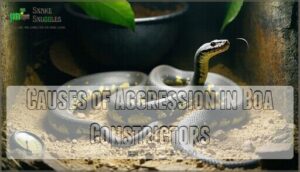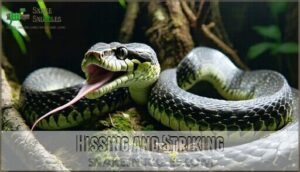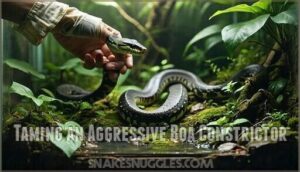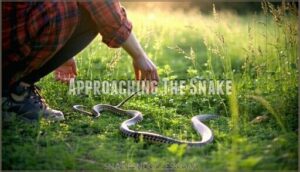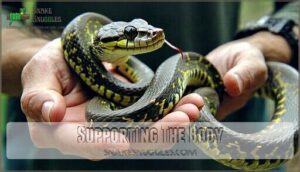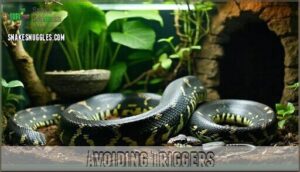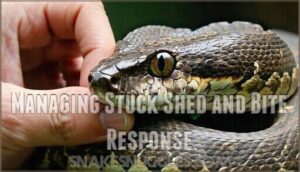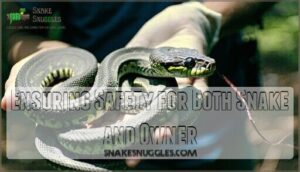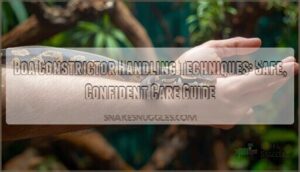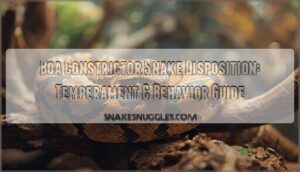This site is supported by our readers. We may earn a commission, at no cost to you, if you purchase through links.
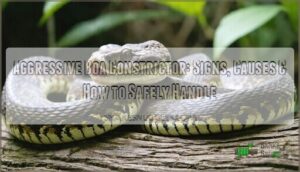 Your aggressive boa constrictor isn’t actually aggressive—it’s defensive. Boas are naturally docile, but they’ll hiss, strike, or coil when stressed, sick, or threatened.
Your aggressive boa constrictor isn’t actually aggressive—it’s defensive. Boas are naturally docile, but they’ll hiss, strike, or coil when stressed, sick, or threatened.
Common triggers include sudden environmental changes, improper handling, health issues, or feeling cornered. You’ll recognize defensive behavior through S-shaped posturing, hissing sounds, and quick striking motions.
The key is patience and proper technique. Start by eliminating stressors like bright lights, loud noises, or temperature fluctuations.
When handling, move slowly and support their body weight. Most "problem" boas calm down once you address the root cause and build trust through consistent, gentle interactions.
There’s more to mastering this relationship.
Table Of Contents
- Key Takeaways
- Is My Boa Constrictor Aggressive?
- Causes of Aggression in Boa Constrictors
- Identifying Defensive Posture
- Taming an Aggressive Boa Constrictor
- Handling Techniques for Aggressive Snakes
- Managing Stuck Shed and Bite Response
- Ensuring Safety for Both Snake and Owner
- Frequently Asked Questions (FAQs)
- Is a boa constrictor aggressive?
- How to make a boa constrictor let go?
- What is the most aggressive constrictor snake?
- Why is my boa trying to bite me?
- Why is my boa suddenly aggressive?
- How to tame an aggressive boa constrictor?
- Are Central American boas aggressive?
- Are boa constrictors aggressive?
- Are boa constrictors a snake?
- Are boa constrictors good pets?
- Conclusion
Key Takeaways
- **Your boa isn’t actually aggressive—it’s defensive.
**True aggression is rare in boas; what you’re seeing is likely stress responses from environmental changes, improper handling, health issues, or feeling threatened.
- **Identify the root cause before attempting to fix the behavior.
**Check for temperature fluctuations, humidity problems, illness signs, or recent changes in their environment that might be triggering defensive responses.
- **Build trust through gradual, consistent handling sessions.
**Start with 5-minute sessions every 3-4 days, move slowly, support their body weight properly, and let them get familiar with your scent before attempting direct contact.
- **Never punish or force interactions with a defensive boa.
**Stay calm if bitten, avoid handling during feeding or shedding periods, and respect their body language signals, like hissing, coiling, or striking motions.
Is My Boa Constrictor Aggressive?
Defining aggression in your boa constrictor isn’t always straightforward.
Normal behavior includes occasional hissing or defensive posturing when startled.
True snake aggression involves persistent striking, tight S-coiling, and mouth gaping during routine interactions.
Fear responses like tail twitching are temporary reactions, while genuine aggressive boa constrictor behavior continues despite consistent, gentle handling frequency.
Temperament differences between individual snakes mean some are naturally more defensive.
Understanding your boa constrictor behavior helps distinguish between normal snake behavior and concerning aggression causes requiring intervention.
Causes of Aggression in Boa Constrictors
Your boa’s aggressive behavior usually isn’t random but stems from specific triggers you can identify and address.
Understanding these causes, from poor handling to environmental stress, helps you create better conditions and reduces defensive reactions in your snake, by addressing the specific triggers and improving the environment to reduce defensive reactions.
Mistreatment
Mistreatment creates lasting behavioral issues in boa constrictors through fear conditioning.
Abuse trauma from rough handling errors or neglect impact transforms naturally calm snakes into defensive animals.
Your aggressive boa constrictor develops boa constrictor aggression management needs when previous owners used punishment or inadequate care.
Mistreatment remains a primary aggression cause requiring patient rehabilitation.
Adult boas require a vivarium of at least 6 feet by 2 feet, so owners should consider appropriate enclosure requirements to minimize stress.
Key mistreatment factors causing aggression:
- Physical punishment like head-smacking increases defensive responses
- Inadequate enclosures create chronic stress and territorial behavior
- Poor handling techniques teach snakes to associate humans with danger
- Neglect of basic needs leads to fear-based striking and constriction
- Inconsistent care routines prevent proper socialization and trust-building
Environmental Changes
In regards to environmental changes, your boa’s world can flip upside down faster than you’d expect.
These shifts create stress that manifests as aggressive behavior. It’s also worth noting that boas may exhibit aggression due to hormonal changes during breeding season.
Key environmental stressors include:
- Temperature gradients that fluctuate unpredictably, disrupting your snake’s thermoregulation
- Humidity levels dropping below ideal ranges, causing discomfort and defensive responses
- Enclosure size changes or inadequate lighting schedules affecting natural behavior patterns
Health Issues
When your boa’s feeling under the weather, aggression often follows.
Sick snakes become defensive snakes—discomfort drives aggression faster than you’d expect.
Health issues like respiratory infections, scale rot, and mouth rot create discomfort that triggers defensive behavior.
A sick snake becomes a cranky snake.
| Common Health Problem | Aggression Trigger |
|---|---|
| Respiratory Infections | Breathing difficulty causes stress |
| Parasite Prevention Issues | Internal discomfort increases irritability |
| Obesity Risks | Reduced mobility creates anxiety |
Regular veterinarian visits catch snake illness early, preventing regurgitation and maintaining peak snake health.
Identifying Defensive Posture
You’ll notice your boa’s defensive posture through specific body language signals that clearly indicate stress or fear.
When threatened, boas typically coil into a tight ‘S’ shape, flatten their heads and necks, and may hiss while gaping their mouths as warning signs.
Body Language
Recognizing your boa’s defensive postures starts with watching their body language carefully.
An aggressive boa constrictor displays distinct coiling signals – they’ll form a tight ‘S’ shape, flatten their head, and keep their mouth open as a warning. You’ll also notice tail twitching and raised positioning that screams "back off!"
Key snake body language warning signs include:
- Head flattening – your boa makes itself appear larger and more threatening
- Tight coiling – defensive posture that prepares them for striking or quick escape
- Open mouth gaping – a clear "stay away" message that shouldn’t be ignored
- Raised neck positioning – elevating their head shows they’re ready to defend themselves
- Tail twitching – rapid movements signal high stress and potential aggression
Hissing and Striking
Before attempting to handle your aggressive boa constrictor, you’ll notice hissing intensity and strike accuracy increase when they feel threatened.
This defensive posture represents bluffing rather than true aggression. Juvenile aggression appears more dramatic, but vocalization meaning signals fear, not malice.
Snakes often increase hissing when experiencing stress or fear responses.
| Behavior | Meaning | Response | Safety Level |
|---|---|---|---|
| Loud hissing | High stress | Back away slowly | Moderate risk |
| Mock strikes | Defensive bluffing | Give space | Low bite response |
| Coiled posture | Ready to defend | Avoid handling | High snake aggression |
| Open mouth | Warning signal | Stop approaching | Snake bite possible |
Taming an Aggressive Boa Constrictor
You can transform an aggressive boa constrictor into a calm, manageable pet through consistent, patient handling techniques that build trust over time.
This process requires gradual exposure sessions, proper environmental management, and understanding your snake’s specific triggers to create positive associations with human interaction, which helps in making the snake a manageable pet.
Gradual Handling
Patience works wonders when taming your aggressive boa through gradual handling sessions. Start slowly and build confidence over time.
- Begin with 5-minute sessions using reptile gloves and a snake hook for safety
- Handle every 3-4 days to establish consistent routine without overwhelming your snake
- Place worn clothing in the enclosure for scent acclimation between sessions
- Increase session length gradually as your boa becomes more comfortable with handling
Building Trust
Trust-building transforms your boa constrictor’s aggressive behavior into calm acceptance.
Scent Familiarization starts by placing worn clothing in the enclosure.
Always Respect Boundaries when taming shows resistance.
Consistent Interaction through predictable routines helps your snake anticipate handling sessions.
| Trust Method | Timeline |
|---|---|
| Scent Familiarization | 1-2 weeks |
| Positive Reinforcement | Ongoing |
| Consistent Interaction | 2-3 times weekly |
| Predictable Routines | Daily schedule |
Face Training
Face training helps your aggressive boa constrictor recognize you’re not a threat.
Allow the snake to climb on your face and explore your features at its own pace.
This taming technique teaches that your face isn’t food, making future snake handling sessions more relaxed for both of you.
A key aspect involves supporting the snake’s body during these interactions.
- Scent Acclimation: Let your boa smell your breath and skin to build familiarity
- Visual Familiarity: Allow exploration of glasses, hair, and facial features without restraint
- Movement Desensitization: Practice slow head movements while snake investigates your face
- Positive Association: Create calm experiences that reduce fear-based defensive responses
- Patience Importance: Monitor body language and interrupt if striking behavior appears
Handling Techniques for Aggressive Snakes
When you’re dealing with an aggressive boa constrictor, proper handling techniques can mean the difference between a successful interaction and a stressful experience for both you and your snake.
You’ll need to master specific approaches that prioritize safety while gradually building trust through calm, deliberate movements that respect your boa’s defensive instincts.
Approaching The Snake
Initial contact with an aggressive boa constrictor requires reading signals from a safe distance.
Maintain a calm demeanor while observing defensive postures like hissing or coiling.
Gradual introduction prevents triggering fight-or-flight responses.
Move slowly, avoiding sudden gestures that escalate tension.
Using specialized handling equipment can also aid in safely managing the snake.
Proper snake handling begins with patience, allowing your boa to recognize you’re not a threat before attempting direct contact, which involves gradual introduction and calm demeanor to ensure safe interaction, and requires specialized handling equipment.
Supporting The Body
Once you’ve approached your boa successfully, proper grip technique becomes your lifeline.
Support the snake’s body with even weight distribution across your hands and forearms. Never grab just the head or tail – this causes stress and potential injury.
Using specialized tools can also help guarantee a safe interaction, so consider investing in appropriate handling equipment.
Distribute the boa’s weight evenly to provide muscle support, ensuring comfortable handling while maintaining your control and the snake’s wellbeing.
Avoiding Triggers
Supporting your boa properly sets the stage for avoiding aggression triggers altogether. Environmental factors play a huge role in your aggressive boa constrictor’s behavior.
Creating a quiet environment and maintaining predictable routines helps reduce stress substantially. Handling mistakes often stem from ignoring these key triggers that can escalate defensive responses.
Here are essential aggression triggers to avoid:
- Don’t handle after touching rodents – your scent triggers feeding responses
- Wait 48 hours post-feeding to prevent regurgitation stress
- Avoid handling during shedding when eyes appear opaque
- Keep prey animals away from handling areas
- Choose low-traffic locations for snake handling sessions
To guarantee safety, consider using specialized handling equipment. These snake calming techniques guarantee your secure enclosure remains a safe space for both you and your boa.
Managing Stuck Shed and Bite Response
When your boa can’t shed properly, the discomfort often increases aggressive behavior, making calm handling even more essential.
If you do get bitten during shedding issues, your reaction determines whether your snake learns that biting works or that you’re still a safe presence.
Humidity and Hydration
Proper humidity levels between 60-70% prevent shedding problems and keep your boa healthy.
Monitor hydration signs like wrinkled skin or dull eyes.
Make certain constant water availability with a large bowl your snake can soak in.
Use gentle misting techniques around the enclosure, not directly on your boa.
A humidity hide with damp moss provides extra moisture when needed.
Calm Reaction to Bites
Getting bitten happens, but your reaction sets the tone for future interactions. Stay composed—panic only escalates your snake’s stress.
Clean the wound immediately with soap and water to prevent infection, then apply a sterile bandage. Don’t reward biting behavior by returning your boa to its enclosure right away.
A common issue, especially during shedding, is retained skin patches, which can also make snakes irritable.
Essential bite response steps:
- Remain calm and assess the snake bite severity
- Clean thoroughly and watch for infection signs
- Wait before returning snake to prevent reinforcing bite behavior
Ensuring Safety for Both Snake and Owner
Smart safety practices protect both you and your aggressive boa constrictor from unnecessary harm. Create safe enclosures with secure locks and proper ventilation to prevent escapes. Use handling equipment like snake hooks and feeding tongs to maintain safe distances during interactions.
Bite prevention starts with reading your snake’s body language—respect defensive postures and avoid handling during feeding or shedding periods. Always wash your hands before and after contact to eliminate food scents that trigger strikes. Knowing how to identify venomous snake features is also essential for responsible snake ownership.
| Safety Category | Equipment | Purpose |
|---|---|---|
| Handling | Snake hooks, gloves | Maintain safe distance |
| Feeding | Feeding tongs, secure lid | Prevent snake bite incidents |
| Emergency | First aid kit, vet contact | Quick response protocols |
Responsible ownership means establishing emergency protocols before problems arise. Master these snake handling techniques and you’ll build confidence while keeping everyone safe.
Frequently Asked Questions (FAQs)
Is a boa constrictor aggressive?
Boa constrictors aren’t naturally aggressive.
They’re typically calm, docile snakes that only show defensive behavior when stressed, threatened, or improperly handled.
With proper care and gentle handling, they make peaceful pets.
How to make a boa constrictor let go?
Stay calm and don’t pull.
Pour cool water over the snake’s head or gently touch its tail.
You can also use rubbing alcohol on a cotton swab near its mouth to encourage release.
What is the most aggressive constrictor snake?
Ironically, you’d expect pythons to top the aggression charts, but reticulated pythons actually claim that dubious honor.
They’re notoriously defensive, quick to strike, and won’t hesitate to bite when they feel threatened or cornered.
Why is my boa trying to bite me?
Your boa’s trying to bite because it feels threatened or stressed.
Poor handling, wrong temperatures, hunger, illness, or feeling cornered triggers this defensive behavior.
It’s not personal—just survival instincts kicking in.
Why is my boa suddenly aggressive?
Your usually docile snake may be experiencing stress from environmental changes, improper temperatures, hunger, illness, or feeling threatened.
Check habitat conditions, recent handling practices, and consider a veterinary examination to identify underlying causes, which may involve environmental changes.
How to tame an aggressive boa constrictor?
Gradually build trust through consistent, gentle handling sessions.
Start with short 10-minute sessions twice weekly, using snake hooks and gloves.
Move slowly, support their body loosely, and avoid sudden movements during interactions.
Are Central American boas aggressive?
Like a misunderstood guardian, Central American boas aren’t naturally aggressive.
You’ll find they’re typically calm, docile snakes when properly cared for.
Their defensive behavior usually stems from stress, poor handling, or inadequate environmental conditions rather than inherent aggression.
Are boa constrictors aggressive?
Most boa constrictors aren’t naturally aggressive.
You’ll find they’re typically calm, docile snakes that only become defensive when they feel threatened, stressed, or mishandled.
Proper care and gentle handling prevent most aggressive behaviors.
Are boa constrictors a snake?
Yes, you’re dealing with a true snake here.
Boa constrictors belong to the Boidae family of non-venomous snakes.
They’re large, powerful constrictors that squeeze their prey rather than using venom to hunt.
Are boa constrictors good pets?
Boa constrictors can make excellent pets if you’re prepared for their size, longevity, and specific care needs.
They’re generally docile, but require proper housing, temperature control, and commitment to decades of ownership.
Conclusion
Transforming an aggressive boa constrictor is like solving a puzzle—each piece reveals the complete picture.
Your snake’s defensive behavior stems from identifiable causes you can address through patience and proper technique.
By eliminating stressors, maintaining consistent temperatures, and practicing gradual handling methods, you’ll build the trust necessary for safe interactions.
Remember, most aggression disappears once underlying issues are resolved, and with time and dedication, your defensive boa will become the calm companion you originally hoped to have.
- https://www.floridamuseum.ufl.edu/
- https://www.thesprucepets.com/how-to-handle-snakes-safely-1239286
- https://findyourreptile.com/reptile-info/boa-imperator-articles/beginners-guide-to-boa-constrictor-care/
- https://www.anapsid.org/handling.html
- https://reptilesmagazine.com/aggressive-snake-strikes-after-feeding/?srsltid=AfmBOooc0SesCNLxcVxk1gPcIsYVcEMNX0vndJ7lnY5HkqPIZzhIrvzY

